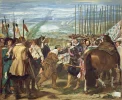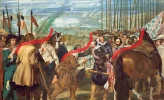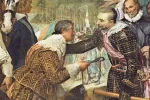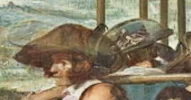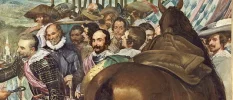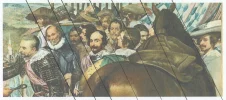Well, I wanted to talk about painting and not about politics. There are very interesting things in this painting, apart from what it represents, or whether it is by Velazquez.
Speaking about the subject, (that I did not want to go into it, since the subjects of the paintings almost never interest me because what interests me is the technique, the aesthetics, the use of color, which are the things that represent themselves in the evolution of painting), the painting represents the surrender of the city of Breda. It was a battle that lasted two years, and this painting is the first painting in the history of painting that represents a surrender in which the humiliated loser is not painted on his knees, and that is the gesture that Spinola, the Spanish general, has, holding him by the shoulder so that he does not kneel.
You can also see a Dutch soldier with his weapon, it is true, in that surrender they were allowed to leave the city with their flags and their weapons, something that was never done. I also have to say that it was normal practice for the victorious army to enter the city and loot it, in this case Spinola prohibited that and the city was respected. I also want to say that the practice of looting was normal at the time and in all countries, it was not a practice of Spanish savages. He painted the Spanish for what they were, old war veterans, the Dutch look younger, and the nobles that are seen behind the Spanish general are the generals who accompanied him, it is not strange that they are painted.
The two figures that look at the ends are a normal practice in the Baroque, and they serve to communicate with the viewer, and to serve as a barrier so that the eyes do not look for what is outside the painting to the right and left, the one who looks to the right is Velazquez himself.
The central element of the painting is the key to the city, and the motif of the painting is what I said, the feeling of respect for courage and of friendship and nobility. The painting was commissioned by the king, of course, and Olivares, a kind of president of the government, asked Velazquez to paint at least the lances, to represent the strength of the victor, Velazquez had to do it, he was the official painter of the king and his freedom regarding his paintings had its limits.
I have chosen this painting for the technical and aesthetic reasons that I said above, hoping to reach interesting conclusions, and thinking that it would serve as a link with a later one, but I think I was wrong.
